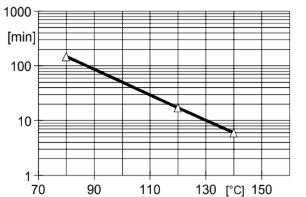Enhanced TDS
Identification & Functionality
- Chemical Family
- Fillers Included
- RTU Product Type
- Technologies
- Product Families
Features & Benefits
- Ready-to-Use Product Features
- Key Properties
- High mechanical and electrical properties
- Good thermal shock resistance
- Possibility of high filler content
- Key Properties
- High mechanical and electrical properties
- Good thermal shock resistance
- Possibility of high filler content
Applications & Uses
- Composites Processing Methods
- Cure Method
- Product End Uses
- Markets
- Applications
- Remarks
- End properties of this system have been tested with the silica filler, quality SUK II. No flexibilizer is added to produce switch parts, pin insulators, but we recommend to add some flexibilizer DY 040 CI (max 20pbw) for the production of instrument and distribution transformers.
- Processing Information
General instructions for preparing liquid resin systems
- Long pot life is desirable in the processing of any casting resin system. Mix all of the components together very thoroughly at room temperature or slightly above and under vacuum. Intensive wetting of the filler is extremely important. Proper mixing will result in:
- better flow properties and reduced tendency to shrinkage
- lower internal stresses and therefore improved mechanical properties on object
- improved partial diskharge behavior in high voltage applications.
- For the mixing of medium- to high viscous casting resin systems and for mixing at lower temperatures, we recommend special degassing mixers that may produce additional selfheating of 10-15°C as a result of friction. For low viscous casting resin sys-tems, conventional mixers are usually sufficient.
- In larger plants, the individual components (resin, hardener) are mixed with the respective quantities of fillers and additives under vacuum. Metering pumps then feed these premixes to the final mixer or a continuous mixer. The individual premixes can be stored at elevated temperature (about 60°C) for up to about 1 week, de-pending on formulation. Intermittent agitation during storage is advisable to prevent filler sedimentation.
- Mixing time can vary from 0.5 to 3 hours, depending on mixing temperature, quantity, mixing equipment and the particular application. The required vacuum is 0.5 to 8 mbar. The vapor pressure of the individual components should be taken into account. In the case of dielectrically highly stressed parts, we recommend checking the quality consistency and predrying of the filler. Their moisture content should be <0.2%.
Specific Instructions
The effective pot-life of the mix is about 1 - 2 days at temperatures below 25°C. Conventional batch mixers should be cleaned once a week or at the end of work. For longer interruptions of work, the pipes of the mixing and metering installllations have to be cooled and cleaned with the resin component to prevent sedimentation and/or undesired viscosity increase. Interruptions over a week-end (approx. 48h) without cleaning are possible if the pipes are cooled at temperatures below 18°C. Viscosity increase and gel time at various temperatures.
Mold temperature
APG process: 120 - 150°C
Conventional vacuum casting: 80 - 100°C
Demolding times (depending on mold temperature and casting volume)
APG process: 10 - 45 min
Conventional vacuum casting: 1 - 6 h
Cure conditions
APG process (minimal postcure): 10h at 140°C
Conventional vacuum casting: 4h at 80°C + 8h at 140°C- To determine whether crosslinking has been carried to completion and the final properties are optimal, it is necessary to carry out relevant measurements on the actual object or to measure the glass transition temperature. Different geling and cure cycles in the manufacturing process could lead to a different crosslinking and glass transition temperature respectively
- Processing Methods
- Automatic pressure gelation process (APG)
- Conventional gravity casting process under vacuum
- Processing Methods
- Automatic pressure gelation process (APG)
- Conventional gravity casting process under vacuum
Properties
- Physical Form
- Processing (Guideline Values)
General instructions for preparing liquid resin systems
- Long pot life is desirable in the processing of any casting resin system. Mix all of the components together very thoroughly at room temperature or slightly above and under vacuum. Intensive wetting of the filler is extremely important.
- Proper mixing will result in: - better flow properties and reduced tendency to shrinkage - lower internal stresses and therefore improved mechanical properties on object - improved partial discharge behaviour in high voltage applications.
- For the mixing of medium- to high viscous casting resin systems and for mixing at lower temperatures, we recommend special thin film degassing mixers that may produce additional self-heating of 10-15 °C as a result of friction.
- For low viscous casting resin systems, conventional anchor mixers are usually sufficient. In larger plants, two pre-mixers are used to mix the individual components (resin, hardener) with the respective quantities of fillers and additives under vacuum.
- Metering pumps then feed these premixes to the final mixer or a continuous mixer. The individual premixes can be stored at elevated temperature (about 60°C) for up to about 1 week, de- pending on formulation.
- Intermittent agitation during storage is advisable to prevent filler sedimentation. Mixing time can vary from 0.5 to 3 hours, depending on mixing temperature, quantity, mixing equipment and the particular application. The required vacuum is 0.5 to 8 mbar.
- The vapor pressure of the individual components should be taken into account. In the case of dielectrically highly stressed parts, we recommend checking the quality consistency and pre-drying of the filler. Their moisture content should be < 0.2%.
Specific Instructions
- The effective pot-life of the mix is about 1 to 2 days at temperatures below 25°C. Conventional batch mixers should be cleaned once a week or at the end of work.
- For longer interruptions of work, the pipes of the mixing and metering installations have to be cooled and cleaned with the resin component to prevent sedimentation and/or undesired viscosity increase.
- Interruptions over a week-end (approx. 48h) without cleaning are possible if the pipes are cooled at temperatures below 18°C. For data on viscosity increase and gel time at various temperatures, refer to Figs: 4.1 and 4.5.
Property Value Unit Condition Mould Temperature (APG process) 120 - 150 °C APG process Mould Temperature (Conventional vacuum casting) 80 - 100 °C Conventional vacuum casting
Demoulding Time (APG process) 10 - 45 min APG process Demoulding Time (Conventional vacuum casting) 1 - 6 hours Conventional vacuum casting
Cure Conditions (APG process) 10h hours APG process (minimal postcure)
Cure Conditions (Conventional vacuum casting) 4h at 80°C + 8h at 140°C hours Conventional vacuum casting
To determine whether cross-linking has been carried to completion and the final proper- ties are optimal, it is necessary to carry out relevant measurements on the actual object or to measure the glass transition temperature. Different gelling and cure cycles in the manufacturing process could lead to a different cross-linking and the glass transition temperature respectively.
Processing Viscosities
Fig.4.1: Viscosity increase at 25 40 and 60°C (measurements with Rheomat 115) (Shear rate D = 10 s-1) (Accelerator DY 062 CI: 0.8 pbw)
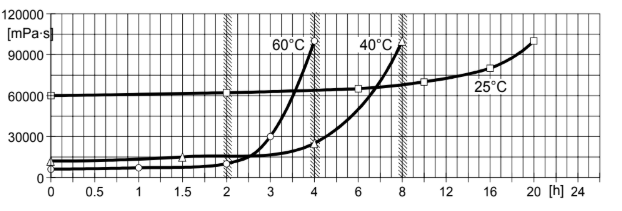
Fig.4.2: Initial viscosity in function of temperature (measurements with Rheomat 115, D =10 s-1) (without Flex. / Filler: 65%)
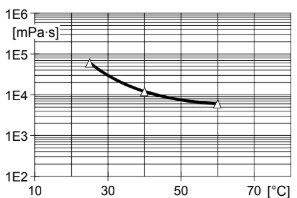
Fig.4.3: Initial viscosity in function of temperature (measurements with Rheomat 115, D =10 s-1)
(Flex. DY 040 CI: 20 pbw / Filler: 65%)
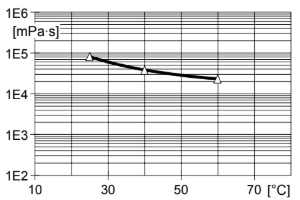
Gelation-/Cure Times
Fig.4.4: Geltime measured with Gelnorm Instrument in function of temperature (DIN 16945/6.3.1) (Acc. DY 062 CI: 0.8 pbw)
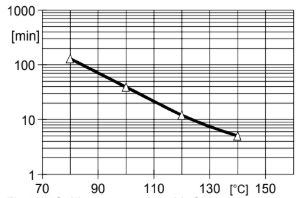
Fig.4.5: Geltime measured with Gelnorm Instrument in function of temperature (DIN 16945/6.3.1) (Acc. DY 062 CI, part : 0.8 pbw / Flex. DY 040 CI: 20 pbw)
